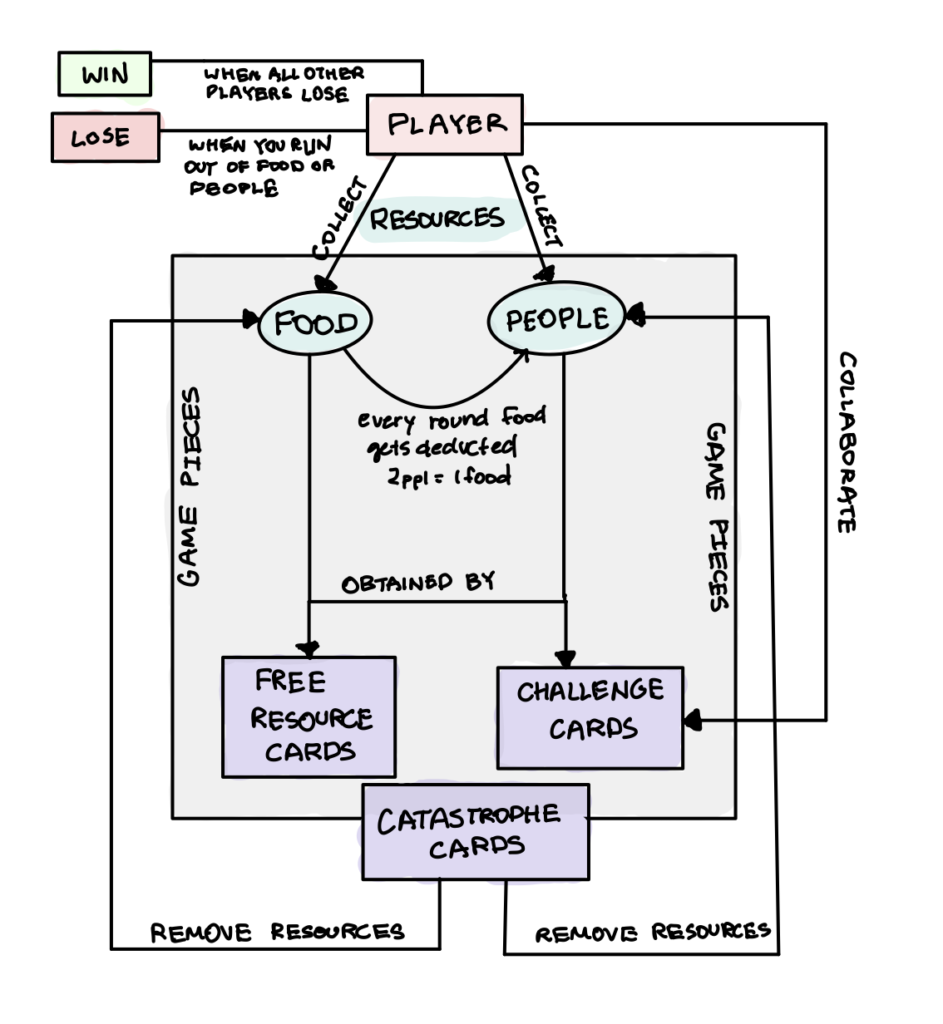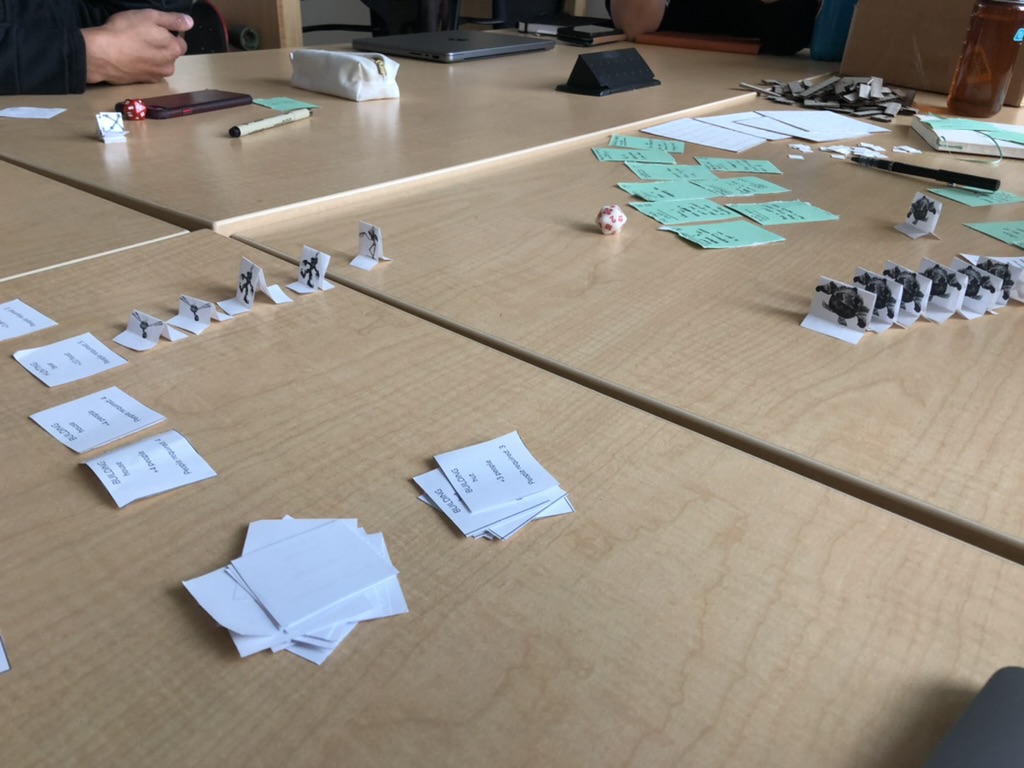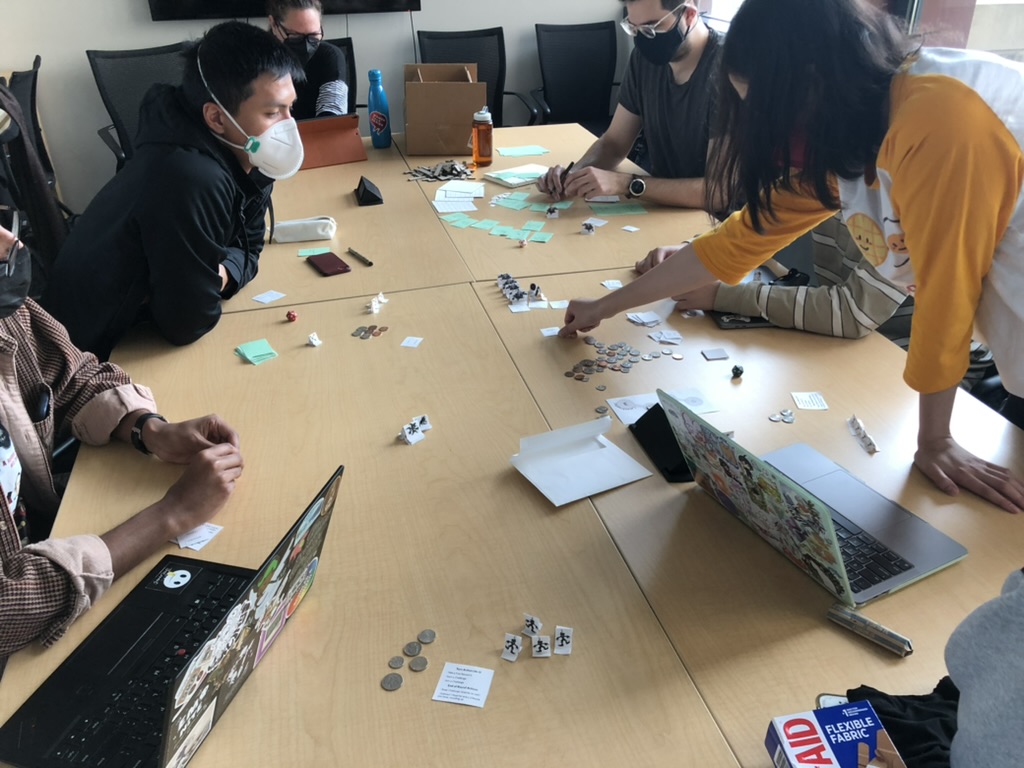P3 by Katherine L, Melody Y, Thomas H, Kavita S
Artist’s Statement
“The tragedy of the commons is a situation in which individual users, who have open access to a resource unhampered by shared social structures or formal rules that govern access and use, act independently according to their own self-interest and, contrary to the common good of all users, cause depletion of the resource through their uncoordinated action.” – Wikipedia
For Project 3, we made Tragedy of the Commons, a game roughly based on the phenomenon of the same name. The premise of the game is surviving in a post-apocalyptic world, and the last player standing wins. In order to survive, a player must have a population of size greater than zero at all times and may not have more than one consecutive turn with zero food. A limited pool of food is accessible by all players, but one player’s greedy actions can leave others starving. A player’s population is limited by the amount of food they have, and the amount of food they can get is limited by their population. The two resources balance each other out. Players must also plan ahead for catastrophes which happen every three turns. One particularly catastrophic event can wipe out a player’s population, taking them out of the game.
Through our game, we want players to experience the consequences of taking resources from unregulated but limited shared resources for their own benefit with no regards for others. Not only does it negatively impact other players when one player takes all the food from the pool, but it also affects a player’s own resources when their population grows out of control and cannot sustain itself on such little food.
Concept Map

Initial Decisions and Values
Initially, we wanted to do a collaborative game that was about community living. In this version, the game went on for as long as possible until everyone died. If the entire group could last a certain number of turns, then it would be a successful game.
During the game, four Challenge cards would always be on the table. Challenge cards had tasks like “Build a house” or “Go hunting.” Each Challenge would require a certain number of People to complete, and they each had a time limit. For example, a Challenge with a time limit of 3 meant that it had to be completed in three turns. In each turn, players had the choice to either send People to start Challenges or grab Food, which was for the collective good. Specialized People could finish Challenges faster or get more Food from a Challenge. For example, a Person that was a Hunter could receive more Food if sent to do a Challenge that rewarded Food.
For every three Challenges that were not completed before their time limits expired, a Catastrophe would be triggered. Catastrophes caused all players to lose People and/or Food. When no players had any People left, everyone would lose. We thought that the collaborate gameplay would teach players the teamwork required for harmonious community living.
Testing and Iterations
Version 2
After playing our initial version, we found that the quarterbacking problem was a major issue in our game. Since everyone was playing on the same team, some players didn’t really have a choice in their actions, since there would usually only be one clear choice to make that would not let the team lose. For example, if a Challenge card was about to reach its time limit, whoever was playing during that turn would have no choice but to do that Challenge, whereas players before them had the choice to gather resources or do that Challenge. This was not fun, since players felt like they had no agency and were not really “playing.” We also found that having too many elements made the game too confusing, so we cut out many.
We decided to shift the focus of the game from “community living” to “tragedy of the commons.” To better illustrate this theme, we changed the game from a collaborative game to a competitive battle royale, where the last player standing wins. The following are the major changes we made from Version 1 to Version 2.
- There are now no specialized workers. Now, every People token has the same value in completing Challenges.
- Before, players went in a set order every round. Often, players who went later in the round did not really have a choice of what action to do, given the cards left on the table. It became especially unfair when that player was last every single round. When the game was collaborative, the quarterbacking problem was also a prominent issue. Now, players roll initiative at the start of each round to determine order, like in Dungeons & Dragons. The introduction of randomness makes it so that players can have an advantage or disadvantage at any time.
- We got rid of the time limit on Challenge cards. The time limits proved to be too tedious and confusing to keep track.
- Without time limits, we had to change the way catastrophes were triggered. Catastrophes are now triggered after every 3rd round.
- Since we got rid of the time limit on Challenge cards that would trigger Catastrophes, there was little incentive for players to do Challenges. Thus, we made it so that Challenge cards would reward more resources than Free Resource cards if successfully completed.
Version 3
After changing the game to a battle royale, we playtested again with our class. Here is the feedback we received and the changes we made in Version 3.
- Playtesters thought that rolling initiative at the start of every round was too bothersome and confusing to keep track. We changed the game so that the order of players is the same every round, but the player who goes first rotates every round.
- We were worried that some players would always have enough People such that the Catastrophes never outright kill them. This worry turned out to be unfounded, since if players had too many People, their Food supply would dwindle and become the limiting factor.
- Players had concerns about themes of colonialism. We do not want the focus/theme of our game to be colonialism, so we re-emphasize the premise of the game being set in a post-apocalyptic world, where all of civilization have been destroyed and must be rebuilt again.
- Players who die early don’t have much to do and may lose interest in replaying the game. This is a problem for which we have not yet found a satisfactory solution.
Playtesting V2 in class
Rules
Here are the rules of Version 3 of Tragedy of the Commons!
Setup
This game is for 4-6 players.
- 4 players: start with 3 Free Resource cards, 3 Challenge cards on the table
- 5-6 players: start with 4 Free Resource cards, 4 Challenge cards on the table
As players die, remove cards.
- 3 players left: 2 free resource cards, 2 Challenge cards on the table
- 2 players left: 1 Free Resource card, 1 Challenge cards on the table
At the beginning of each round, make sure there are always the proper number of Free Resource cards and Challenge Cards on the table.
Shuffle the rest of the cards in their respective decks and lay them face down on the table
- 1 deck of Free Resource cards
- 1 deck of Challenge cards
- 1 deck of Catastrophe cards
Players each start with 2 People tokens in a color of their choosing and 3 Food tokens. Food tokens are shared among all players. There should be no more than 45 Food tokens at all times. This includes Food tokens owned by players and Food tokens in the public domain.
You can use 45 coins for Food tokens. You can use any small objects for People tokens, as long as you have 6 distinct types of People for a maximum of 6 players.
Procedure
- For the first round, decide who goes first in a fair way (roll dice, rock paper scissors, whose birthday is next, etc.). Play order goes clockwise. In subsequent rounds, the player who goes first rotates clockwise. That is to say, in the second round, the first player is the person who played second in the previous round, and the last player is the person who played first in the previous round.
- On your turn, you have 1 action.
- Take a Free Resource card – Immediately get the resource(s) listed on the card (People or Food) and place the card in the Free Resource discard pile. Do not replace the card until after the round is over.
- Start a Challenge – Send some People to do a new Challenge. Challenge cards will reward more resources than Free Resource cards, but they require a certain number of People to do them. However, keep in mind that you will only get the rewards if the person requirement is met exactly. You may send any number of People up to the number listed on the card. To send People to do the Challenge, place People tokens next to the Challenge card. Leave them there until the end of the round.
- Join a Challenge – If a player previously in the round sent People to a Challenge but did not send enough needed to finish the Challenge, you may help complete the Challenge by sending some of your People as well. The rewards given by the Challenge card will be proportional to the number of People you sent. For example, if the Challenge card requires 5 People and rewards 10 Food, and you sent 3 People, you would receive 6 Food at the end of the round. (Note: players are allowed to converse and agree to collaborate on a Challenge, although players are also allowed to betray each other…)
- The round ends when everyone has taken their turn. If you completed a Challenge, you can receive your rewards now. However, if the People requirement for the Challenge was not met, you will not receive any rewards.
- Take back any People that you sent to do Challenges, even if you did not receive rewards. Place completed Challenge cards in the Challenge card discard pile and replace missing cards.
- Replace any missing Free Resource cards.
- Subtract 1 Food per 2 People that you have. If you have an odd number of People, round up. For example, if you have 5 People, subtract 3 Food. Do not worry about negative numbers. Negative Food is the same as 0 Food.
- If you have 0 Food left, you have one more round to try to get more Food. If you still have 0 Food by the end of the next round (after Step 6), you die.
- Move the round counter up by 1. After you reach 3 rounds, draw a Catastrophe card and replace the counter back at 0. Every player must immediately discard the number of People or Food listed on the Catastrophe card. Place the card in the Catastrophe card discard pile.
- If you have 0 People left, you die immediately.
- If there are no more Food or People tokens left in the general pile, the game rounds proceed as normal, except you don’t get any resources for completing Challenges or taking Free Resources. You still have to do Steps 6 and 8.
- If there are no more cards, shuffle the discard pile and place it face down again.
- The game ends when one player is left standing!




